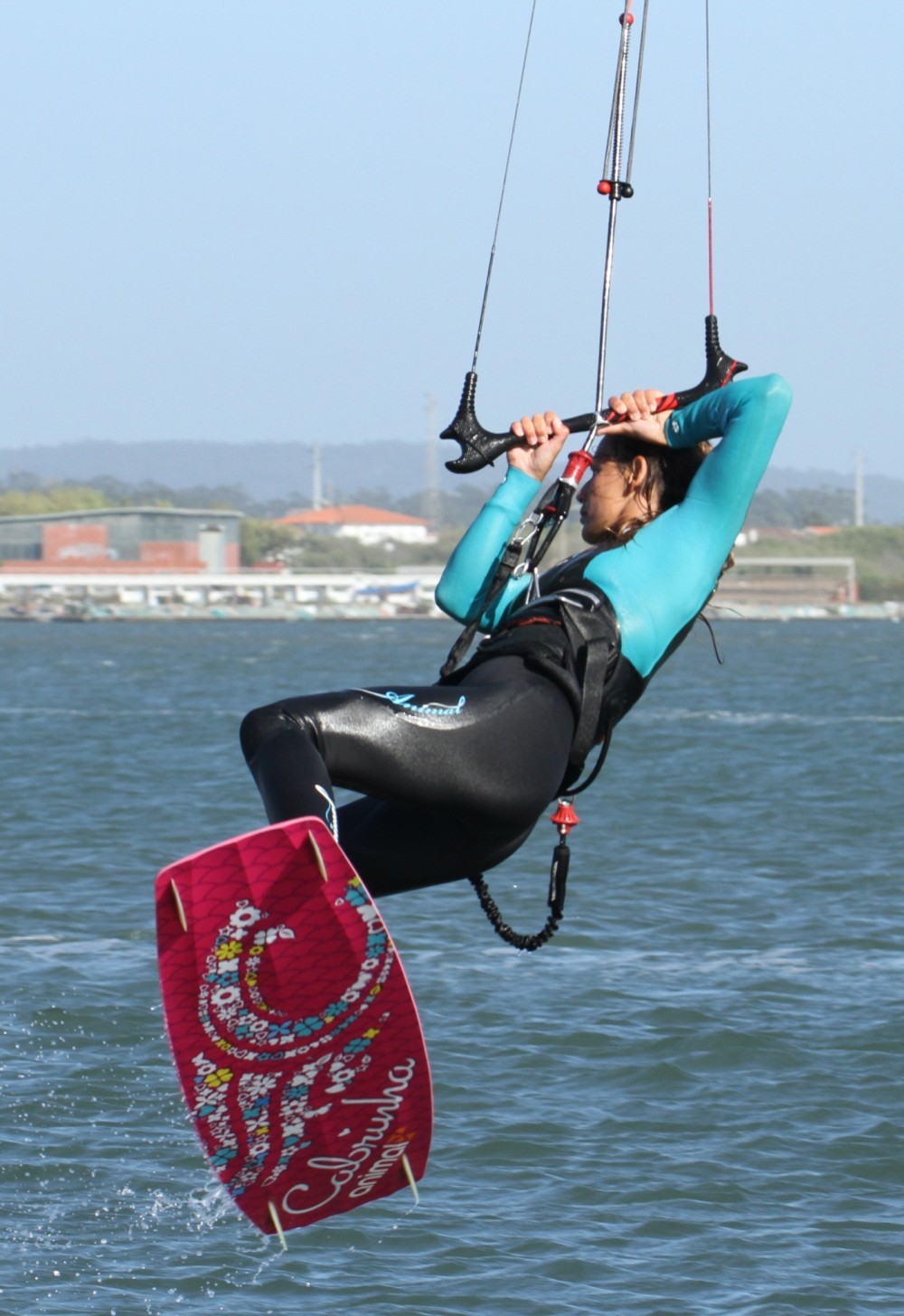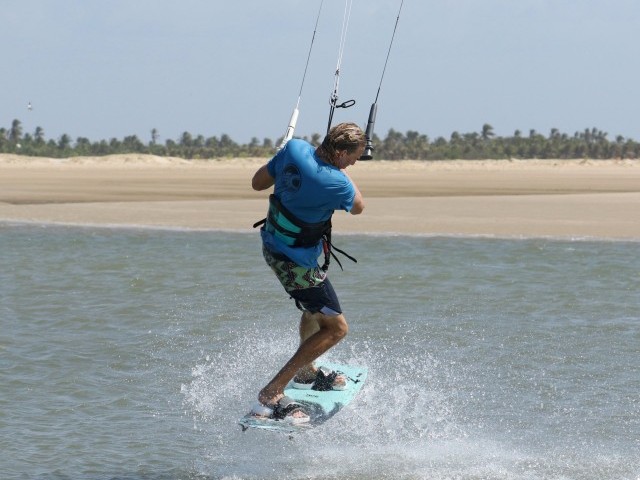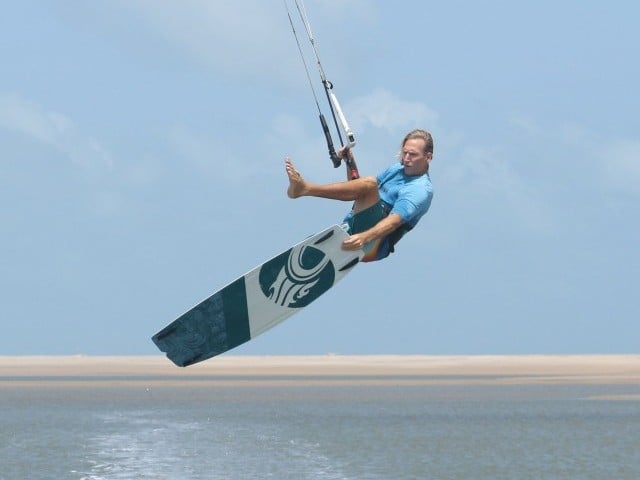
Back Loop From Toeside to Toeside
Technique / Intermediate
Introduction
Yup, the name gives it away, and if you’ve done your homework from the last issue, you’ll be ready and primed. We’ll keep this one pretty brief, as it is an extension of the back loop from toeside, using the kite to jump, from last time, so if you need reminding of the A-B please read the last one. If you’ve nailed it read on…..
So assuming that you’re happily getting up off the water, into a nice slow back loop and landing comfortably off the wind in a heelside manner lets have a look and see what you’ll need to add or change to get this puppy around to toeside.
Finishing the Backloop - Pic A
We can see that Karine as she is about to rotate around to have her front shoulder and the board point downwind. Getting here the important thing was to keep the bar in and get your knees up so that you are rotating as one and not leaving your legs behind. In this position Karine is looking to see the water so that she is aware of her position in the rotation. With tension on the lines and the kite steered slightly in front of her, Karine is floating forwards and is therefore not spinning uncontrolled under the kite.
Pic B
Karine is setting up for her turn to toeside. She has completed her back loop, and now her shoulders and board are across the wind. She has kept her knees up so that she can use them with her hips to turn when its time for her to put the landing gear down. Her intention is not to keep rotating to toeside, as if she does this it will be potluck if she lands correctly or not. Her aim is to turn her lower body to toeside as she comes down. You can see that she is diving the kite. The resulting pull will make it simpler to turn onto her toes, as she can “lean” upwind against it, much as you would on the water, and also it will stop her backloop rotation.
Pic C
As Karine drops down with the pull from the kite she looks forwards to where she expects to land and ride off to (she is not looking downwind), she pulls her back knee and leg through under the bar, which lifts what will be the front of the board, as if rolling her hips towards her hands, and she drops her front shoulder down and upwind which swings her hips around – yet again much as you would do on the water. If you have given the kite a good dive down you could now drop your front hand to help with the toeside landing if you fancy. From this position it should be possible to land with speed, on the tail of the board, but with your weight forward enough so that you’ll not dig in the edge and stop or bounce.
Top Tips
Without a doubt the best tip for nailing the toeside landing is to have your kite moving forward and give it a healthy dive before landing. The forward momentum and “lower kite position result in a fairly natural movement to toeside. If the kite is floating at 12 it can be hard to pull the back leg through, and you’ll end up trying to rotate around which won’t be pretty.
Keeping both hands fairly central on the bar will also help loads. It means that as you roll your hips around you can keep you hands locked in position, almost pulling the bar back without the kite moving too much either way. If you need to take your front hand off to balance for the landing it means that the kite won’t lurch up either.
Finally really make a point of looking where you want to go as you come down. To ride toeside you need to look almost upwind so that your body assumes the right position, so being able to control the landing and get onto a toeside edge to steer the kite again will only be possible if you use your head.
Following Sequence 1
- Pic 1. Karine approaches with decent speed, kite at 11 o’clock. She sends the kite hard but short with her weight back and throws herself up and around, lifting her right shoulder and turning her head.
- Pic 2. Half way around the backloop, Karine has the bar in and her knees up. She has redirected the kite forward to give herself momentum and to prevent any uncontrollable spin.
- Pic 3. As Karine sees the water downwind of her she pulls on her front hand to dive the kite down, which will stop her rotation.
- Pic 4. To be able to turn to toeside Karine keeps her knees up.
- Pic 5. As she drops down Karine turns her head to look forwards towards where she’d like to go.
- Pic 6. She can now bring her back leg up and through.
- Pic 7. As she does this she can drop her front shoulder upwind and bring her hands and hips towards each other.
- Pic 8. In preparation for the landing Karine keeps her front foot up and extends her back leg, aiming for a tail first landing.
- Pic 9. To help with balance and to guarantee a decent toeside landing with speed, Karine releases her front hand, which enabled her to get a bit more weight forward.
- Pic 10. And claims it with grace and style.
Common Problems
If you are spinning under your kite and over rotating past toeside and then falling backwards. This is a sure sign that you have your kite too high. Bring the kite forward as soon as you take off and start to dive it down as soon as you can see where you’ll land.
If you’re bouncing and stopping when you land. This means that you need either more forward speed and/or you need to get a bit more weight forward as you land. Once again taking off and landing with speed is key. And with the kite lower when you come down you’ll be able to pull yourself forwards on the bar for a balanced and trimmed landing.
Keystones
- Speed
- Short but sharp send
- Redirect the kite forwards
- Roll shoulder down and back knee through
- Tail first landing BUT with weight forwards.
This technique article was in Issue 29 of IKSURFMAG.
Related
By Christian and Karine
Christian and Karine have been working together as a coaching team, running improver to advanced kitesurfing clinics since 2003.
























